Comprehensive Financial Accounting Assignment Solution, Analysis
VerifiedAdded on 2023/06/07
|17
|2898
|275
Homework Assignment
AI Summary
This document provides a comprehensive solution to a financial accounting assignment, addressing key areas such as changes in accounting standards by the IASB (International Accounting Standards Board) including measurement, presentation, disclosure, and definitions of assets and liabilities. The solution includes detailed calculations for depreciation, adjustments, and share capital accounting, with corresponding journal entries. It also covers current and deferred tax liability calculations, along with journal entries, and provides examples of asset revaluation with associated journal entries. The assignment assesses the student's ability to apply accounting principles to various scenarios, including share capital, depreciation, and tax-related computations, and to prepare appropriate journal entries to reflect the accounting treatment of different transactions and events.
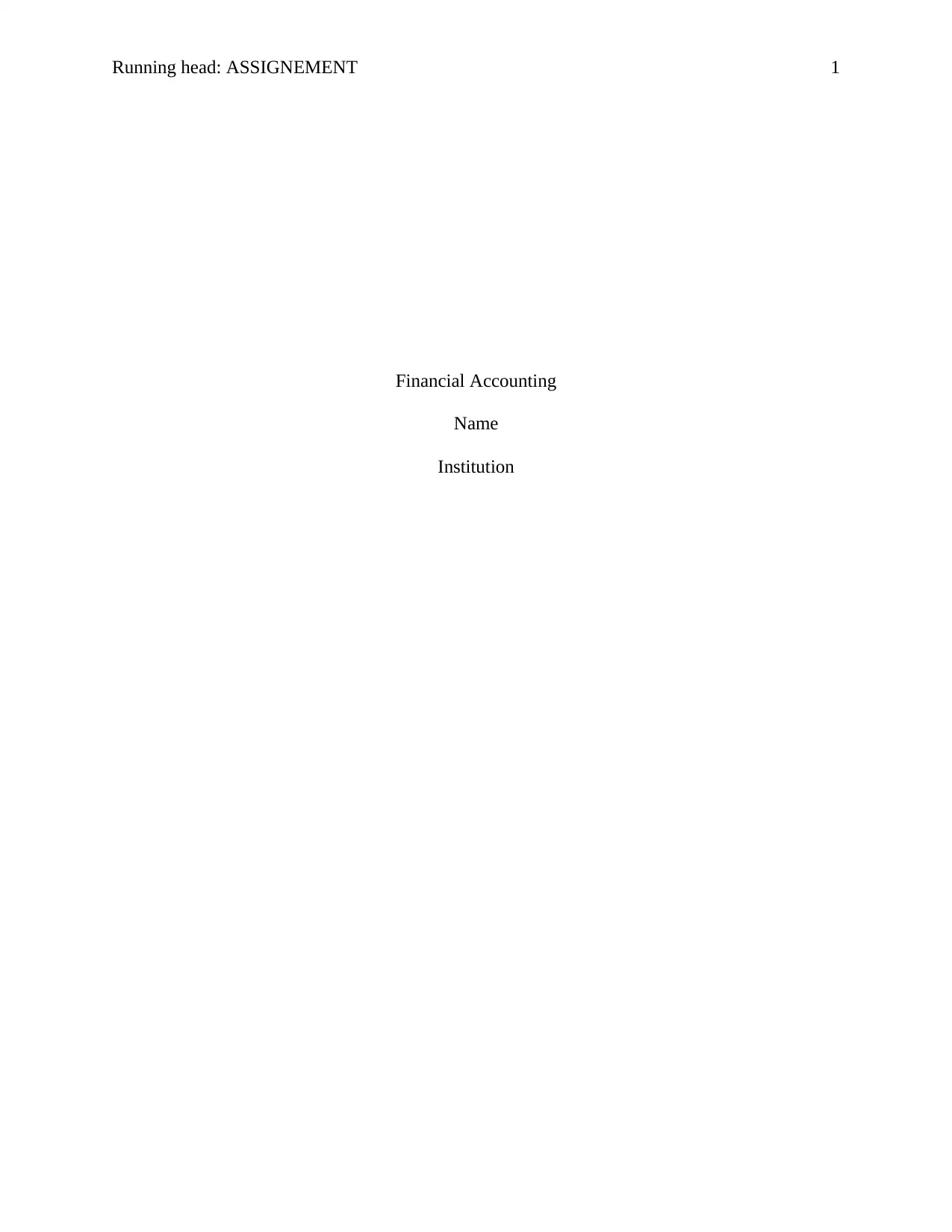
Running head: ASSIGNEMENT 1
Financial Accounting
Name
Institution
Financial Accounting
Name
Institution
Paraphrase This Document
Need a fresh take? Get an instant paraphrase of this document with our AI Paraphraser
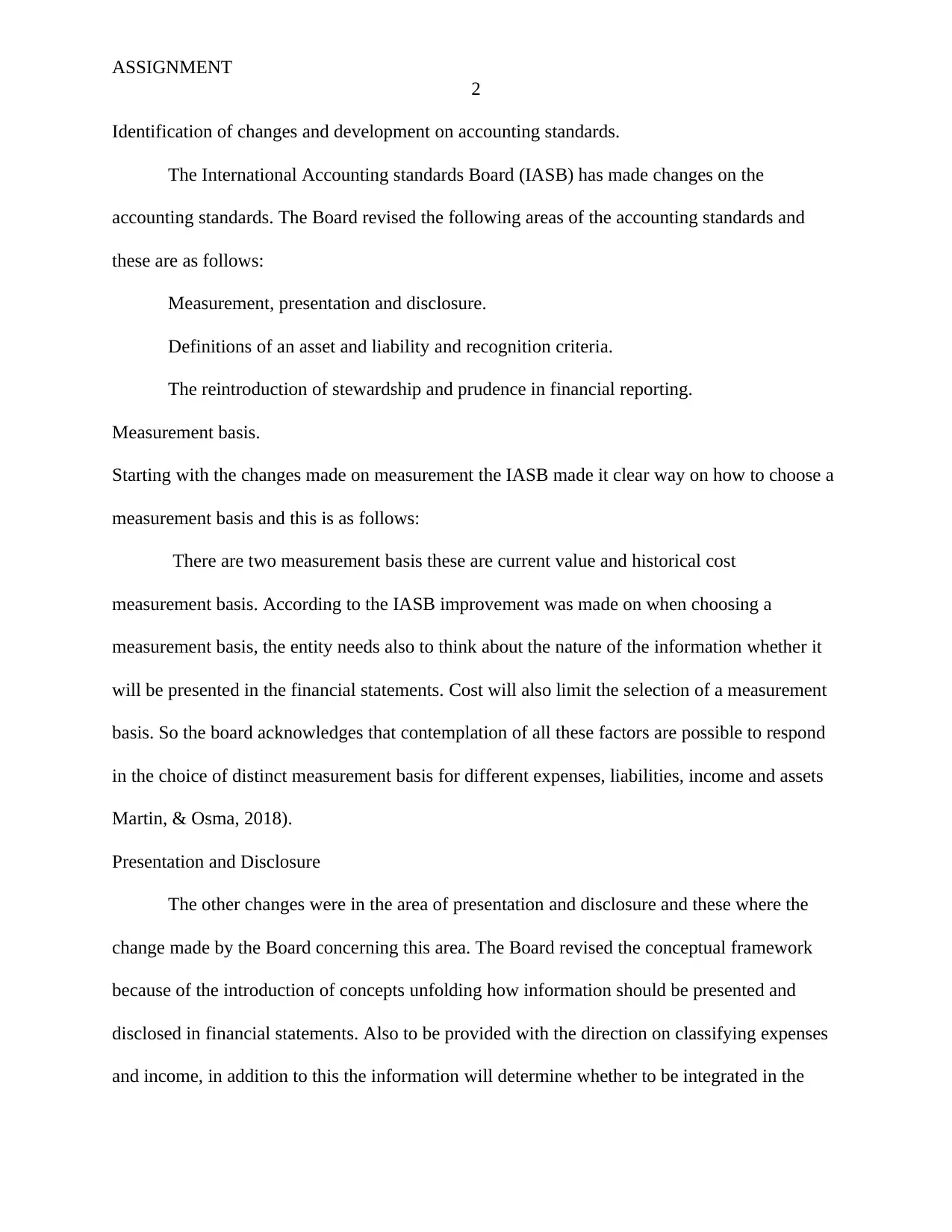
ASSIGNMENT
2
Identification of changes and development on accounting standards.
The International Accounting standards Board (IASB) has made changes on the
accounting standards. The Board revised the following areas of the accounting standards and
these are as follows:
Measurement, presentation and disclosure.
Definitions of an asset and liability and recognition criteria.
The reintroduction of stewardship and prudence in financial reporting.
Measurement basis.
Starting with the changes made on measurement the IASB made it clear way on how to choose a
measurement basis and this is as follows:
There are two measurement basis these are current value and historical cost
measurement basis. According to the IASB improvement was made on when choosing a
measurement basis, the entity needs also to think about the nature of the information whether it
will be presented in the financial statements. Cost will also limit the selection of a measurement
basis. So the board acknowledges that contemplation of all these factors are possible to respond
in the choice of distinct measurement basis for different expenses, liabilities, income and assets
Martin, & Osma, 2018).
Presentation and Disclosure
The other changes were in the area of presentation and disclosure and these where the
change made by the Board concerning this area. The Board revised the conceptual framework
because of the introduction of concepts unfolding how information should be presented and
disclosed in financial statements. Also to be provided with the direction on classifying expenses
and income, in addition to this the information will determine whether to be integrated in the
2
Identification of changes and development on accounting standards.
The International Accounting standards Board (IASB) has made changes on the
accounting standards. The Board revised the following areas of the accounting standards and
these are as follows:
Measurement, presentation and disclosure.
Definitions of an asset and liability and recognition criteria.
The reintroduction of stewardship and prudence in financial reporting.
Measurement basis.
Starting with the changes made on measurement the IASB made it clear way on how to choose a
measurement basis and this is as follows:
There are two measurement basis these are current value and historical cost
measurement basis. According to the IASB improvement was made on when choosing a
measurement basis, the entity needs also to think about the nature of the information whether it
will be presented in the financial statements. Cost will also limit the selection of a measurement
basis. So the board acknowledges that contemplation of all these factors are possible to respond
in the choice of distinct measurement basis for different expenses, liabilities, income and assets
Martin, & Osma, 2018).
Presentation and Disclosure
The other changes were in the area of presentation and disclosure and these where the
change made by the Board concerning this area. The Board revised the conceptual framework
because of the introduction of concepts unfolding how information should be presented and
disclosed in financial statements. Also to be provided with the direction on classifying expenses
and income, in addition to this the information will determine whether to be integrated in the
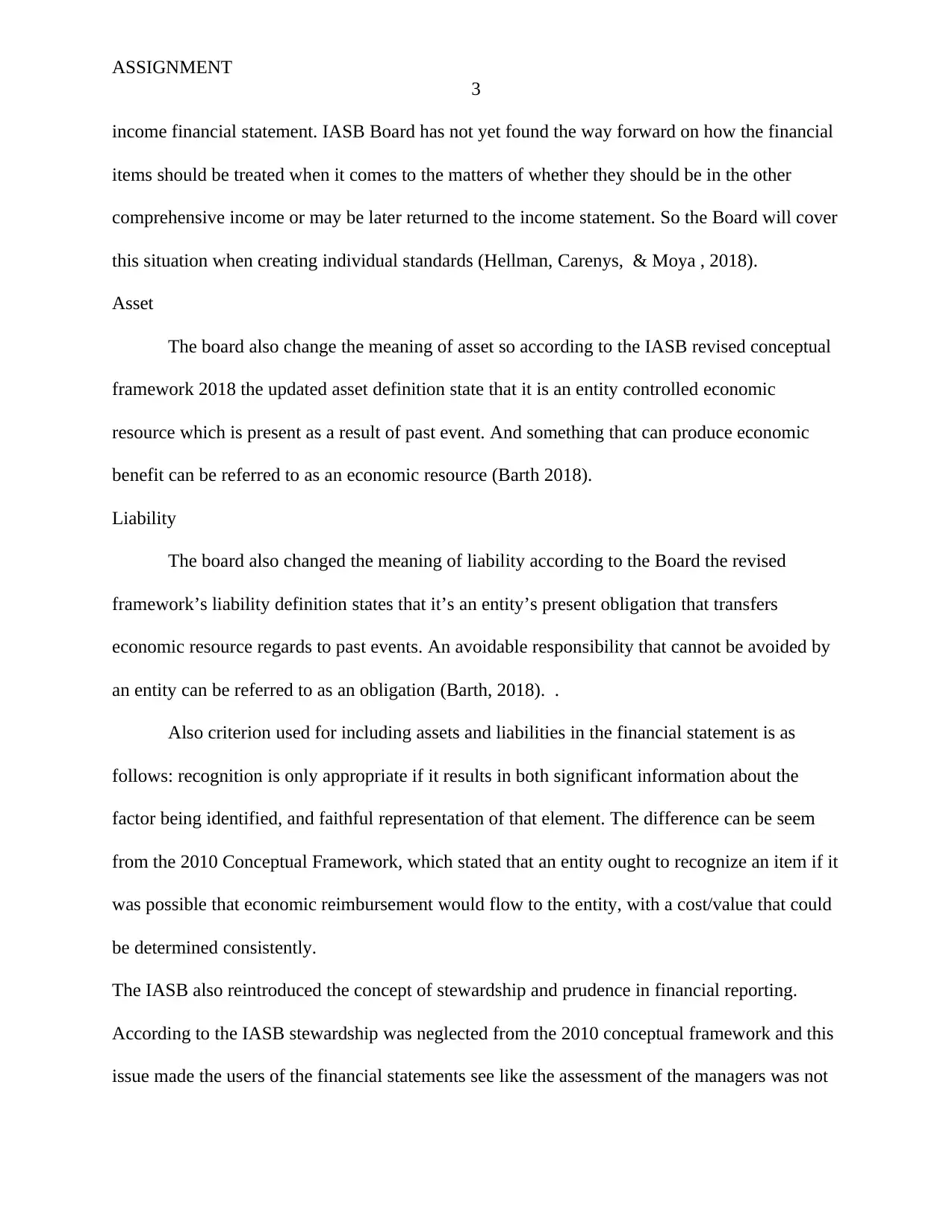
ASSIGNMENT
3
income financial statement. IASB Board has not yet found the way forward on how the financial
items should be treated when it comes to the matters of whether they should be in the other
comprehensive income or may be later returned to the income statement. So the Board will cover
this situation when creating individual standards (Hellman, Carenys, & Moya , 2018).
Asset
The board also change the meaning of asset so according to the IASB revised conceptual
framework 2018 the updated asset definition state that it is an entity controlled economic
resource which is present as a result of past event. And something that can produce economic
benefit can be referred to as an economic resource (Barth 2018).
Liability
The board also changed the meaning of liability according to the Board the revised
framework’s liability definition states that it’s an entity’s present obligation that transfers
economic resource regards to past events. An avoidable responsibility that cannot be avoided by
an entity can be referred to as an obligation (Barth, 2018). .
Also criterion used for including assets and liabilities in the financial statement is as
follows: recognition is only appropriate if it results in both significant information about the
factor being identified, and faithful representation of that element. The difference can be seem
from the 2010 Conceptual Framework, which stated that an entity ought to recognize an item if it
was possible that economic reimbursement would flow to the entity, with a cost/value that could
be determined consistently.
The IASB also reintroduced the concept of stewardship and prudence in financial reporting.
According to the IASB stewardship was neglected from the 2010 conceptual framework and this
issue made the users of the financial statements see like the assessment of the managers was not
3
income financial statement. IASB Board has not yet found the way forward on how the financial
items should be treated when it comes to the matters of whether they should be in the other
comprehensive income or may be later returned to the income statement. So the Board will cover
this situation when creating individual standards (Hellman, Carenys, & Moya , 2018).
Asset
The board also change the meaning of asset so according to the IASB revised conceptual
framework 2018 the updated asset definition state that it is an entity controlled economic
resource which is present as a result of past event. And something that can produce economic
benefit can be referred to as an economic resource (Barth 2018).
Liability
The board also changed the meaning of liability according to the Board the revised
framework’s liability definition states that it’s an entity’s present obligation that transfers
economic resource regards to past events. An avoidable responsibility that cannot be avoided by
an entity can be referred to as an obligation (Barth, 2018). .
Also criterion used for including assets and liabilities in the financial statement is as
follows: recognition is only appropriate if it results in both significant information about the
factor being identified, and faithful representation of that element. The difference can be seem
from the 2010 Conceptual Framework, which stated that an entity ought to recognize an item if it
was possible that economic reimbursement would flow to the entity, with a cost/value that could
be determined consistently.
The IASB also reintroduced the concept of stewardship and prudence in financial reporting.
According to the IASB stewardship was neglected from the 2010 conceptual framework and this
issue made the users of the financial statements see like the assessment of the managers was not
⊘ This is a preview!⊘
Do you want full access?
Subscribe today to unlock all pages.

Trusted by 1+ million students worldwide
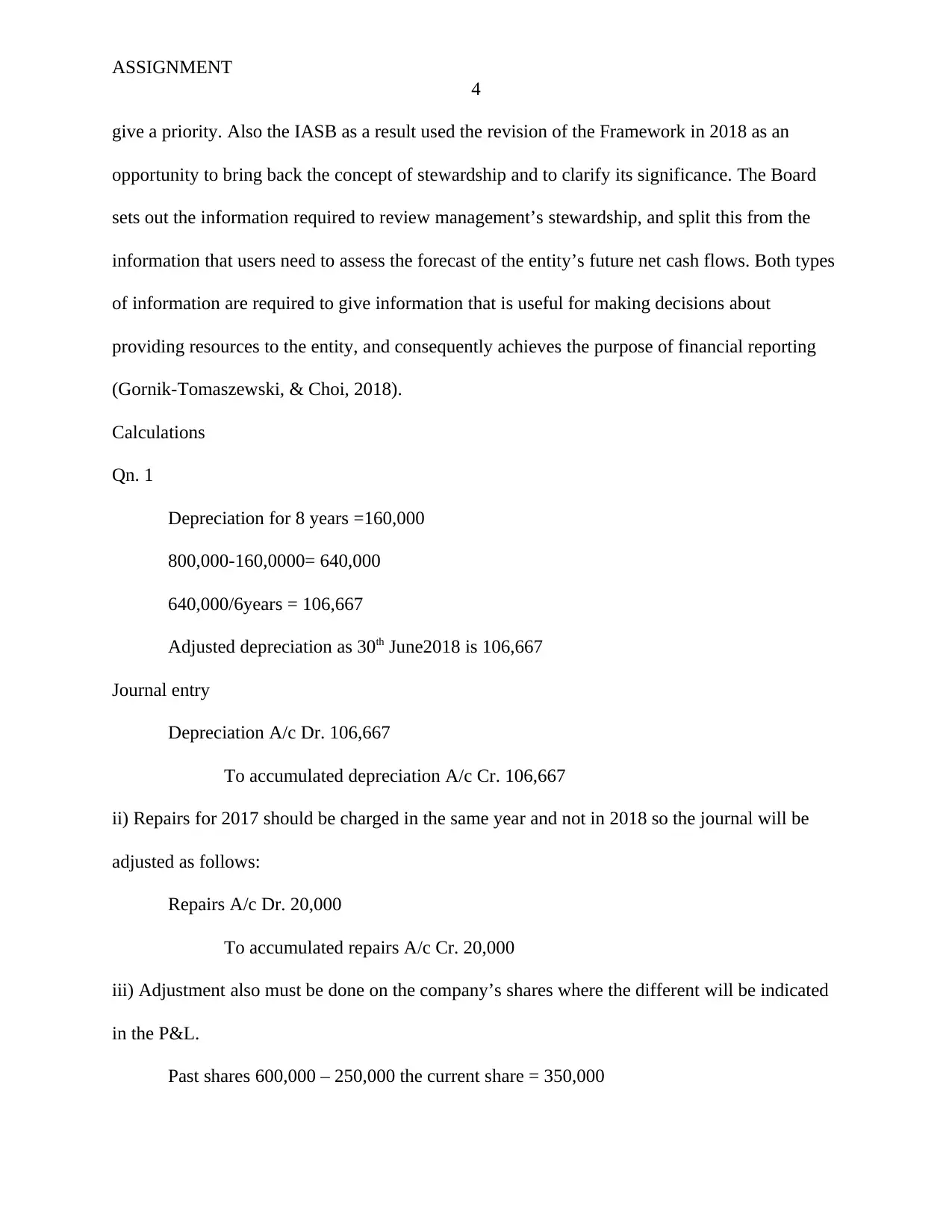
ASSIGNMENT
4
give a priority. Also the IASB as a result used the revision of the Framework in 2018 as an
opportunity to bring back the concept of stewardship and to clarify its significance. The Board
sets out the information required to review management’s stewardship, and split this from the
information that users need to assess the forecast of the entity’s future net cash flows. Both types
of information are required to give information that is useful for making decisions about
providing resources to the entity, and consequently achieves the purpose of financial reporting
(Gornik-Tomaszewski, & Choi, 2018).
Calculations
Qn. 1
Depreciation for 8 years =160,000
800,000-160,0000= 640,000
640,000/6years = 106,667
Adjusted depreciation as 30th June2018 is 106,667
Journal entry
Depreciation A/c Dr. 106,667
To accumulated depreciation A/c Cr. 106,667
ii) Repairs for 2017 should be charged in the same year and not in 2018 so the journal will be
adjusted as follows:
Repairs A/c Dr. 20,000
To accumulated repairs A/c Cr. 20,000
iii) Adjustment also must be done on the company’s shares where the different will be indicated
in the P&L.
Past shares 600,000 – 250,000 the current share = 350,000
4
give a priority. Also the IASB as a result used the revision of the Framework in 2018 as an
opportunity to bring back the concept of stewardship and to clarify its significance. The Board
sets out the information required to review management’s stewardship, and split this from the
information that users need to assess the forecast of the entity’s future net cash flows. Both types
of information are required to give information that is useful for making decisions about
providing resources to the entity, and consequently achieves the purpose of financial reporting
(Gornik-Tomaszewski, & Choi, 2018).
Calculations
Qn. 1
Depreciation for 8 years =160,000
800,000-160,0000= 640,000
640,000/6years = 106,667
Adjusted depreciation as 30th June2018 is 106,667
Journal entry
Depreciation A/c Dr. 106,667
To accumulated depreciation A/c Cr. 106,667
ii) Repairs for 2017 should be charged in the same year and not in 2018 so the journal will be
adjusted as follows:
Repairs A/c Dr. 20,000
To accumulated repairs A/c Cr. 20,000
iii) Adjustment also must be done on the company’s shares where the different will be indicated
in the P&L.
Past shares 600,000 – 250,000 the current share = 350,000
Paraphrase This Document
Need a fresh take? Get an instant paraphrase of this document with our AI Paraphraser
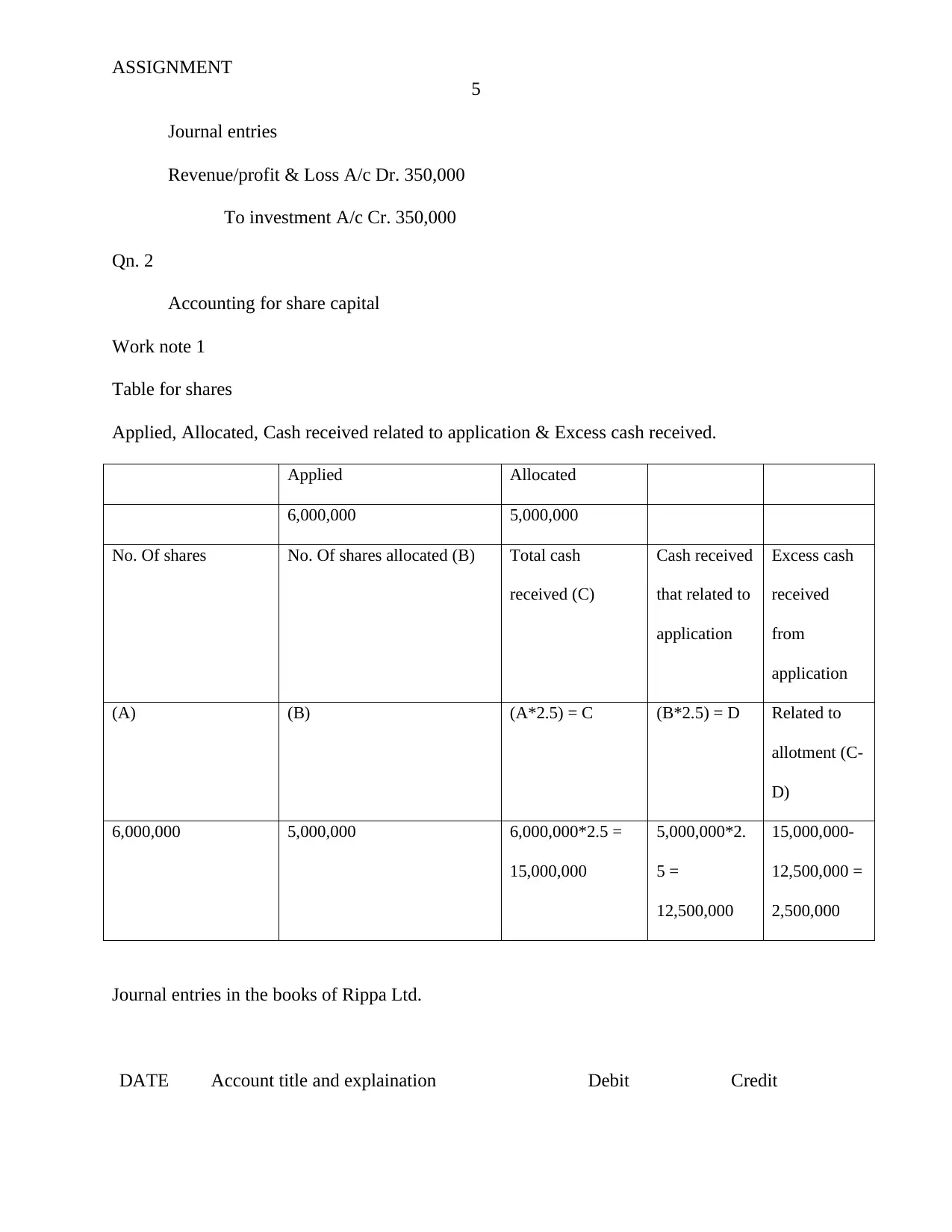
ASSIGNMENT
5
Journal entries
Revenue/profit & Loss A/c Dr. 350,000
To investment A/c Cr. 350,000
Qn. 2
Accounting for share capital
Work note 1
Table for shares
Applied, Allocated, Cash received related to application & Excess cash received.
Applied Allocated
6,000,000 5,000,000
No. Of shares No. Of shares allocated (B) Total cash
received (C)
Cash received
that related to
application
Excess cash
received
from
application
(A) (B) (A*2.5) = C (B*2.5) = D Related to
allotment (C-
D)
6,000,000 5,000,000 6,000,000*2.5 =
15,000,000
5,000,000*2.
5 =
12,500,000
15,000,000-
12,500,000 =
2,500,000
Journal entries in the books of Rippa Ltd.
DATE Account title and explaination Debit Credit
5
Journal entries
Revenue/profit & Loss A/c Dr. 350,000
To investment A/c Cr. 350,000
Qn. 2
Accounting for share capital
Work note 1
Table for shares
Applied, Allocated, Cash received related to application & Excess cash received.
Applied Allocated
6,000,000 5,000,000
No. Of shares No. Of shares allocated (B) Total cash
received (C)
Cash received
that related to
application
Excess cash
received
from
application
(A) (B) (A*2.5) = C (B*2.5) = D Related to
allotment (C-
D)
6,000,000 5,000,000 6,000,000*2.5 =
15,000,000
5,000,000*2.
5 =
12,500,000
15,000,000-
12,500,000 =
2,500,000
Journal entries in the books of Rippa Ltd.
DATE Account title and explaination Debit Credit
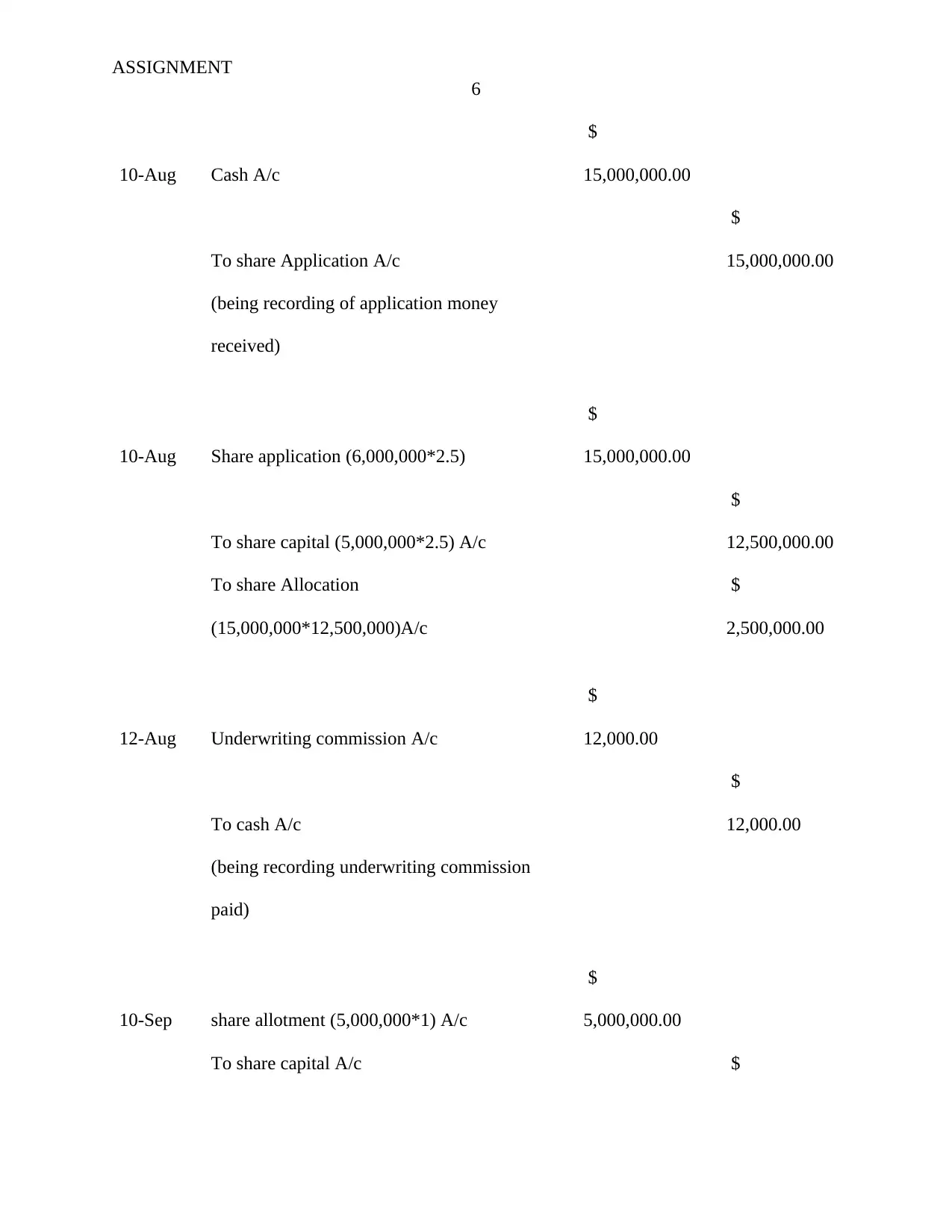
ASSIGNMENT
6
10-Aug Cash A/c
$
15,000,000.00
To share Application A/c
$
15,000,000.00
(being recording of application money
received)
10-Aug Share application (6,000,000*2.5)
$
15,000,000.00
To share capital (5,000,000*2.5) A/c
$
12,500,000.00
To share Allocation
(15,000,000*12,500,000)A/c
$
2,500,000.00
12-Aug Underwriting commission A/c
$
12,000.00
To cash A/c
$
12,000.00
(being recording underwriting commission
paid)
10-Sep share allotment (5,000,000*1) A/c
$
5,000,000.00
To share capital A/c $
6
10-Aug Cash A/c
$
15,000,000.00
To share Application A/c
$
15,000,000.00
(being recording of application money
received)
10-Aug Share application (6,000,000*2.5)
$
15,000,000.00
To share capital (5,000,000*2.5) A/c
$
12,500,000.00
To share Allocation
(15,000,000*12,500,000)A/c
$
2,500,000.00
12-Aug Underwriting commission A/c
$
12,000.00
To cash A/c
$
12,000.00
(being recording underwriting commission
paid)
10-Sep share allotment (5,000,000*1) A/c
$
5,000,000.00
To share capital A/c $
⊘ This is a preview!⊘
Do you want full access?
Subscribe today to unlock all pages.

Trusted by 1+ million students worldwide
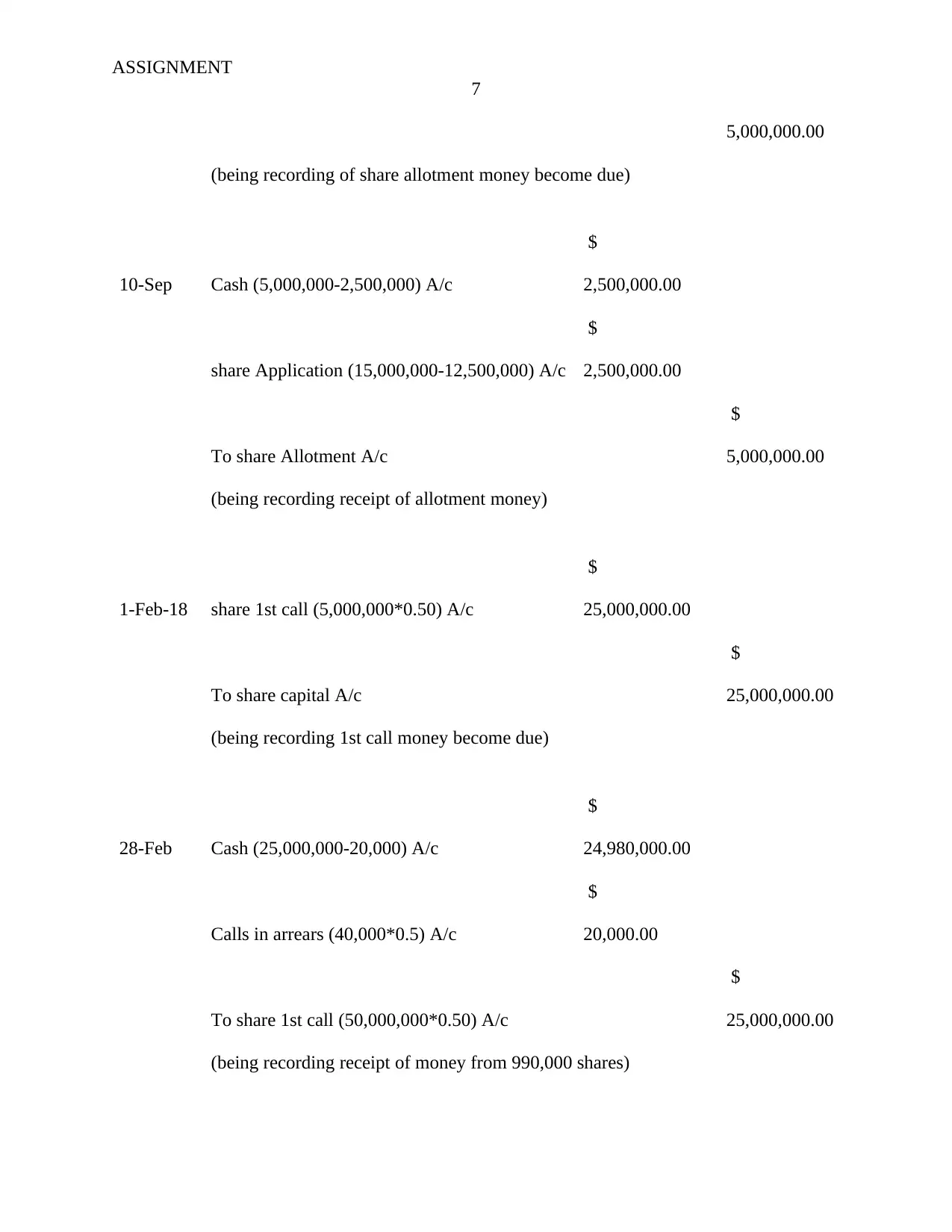
ASSIGNMENT
7
5,000,000.00
(being recording of share allotment money become due)
10-Sep Cash (5,000,000-2,500,000) A/c
$
2,500,000.00
share Application (15,000,000-12,500,000) A/c
$
2,500,000.00
To share Allotment A/c
$
5,000,000.00
(being recording receipt of allotment money)
1-Feb-18 share 1st call (5,000,000*0.50) A/c
$
25,000,000.00
To share capital A/c
$
25,000,000.00
(being recording 1st call money become due)
28-Feb Cash (25,000,000-20,000) A/c
$
24,980,000.00
Calls in arrears (40,000*0.5) A/c
$
20,000.00
To share 1st call (50,000,000*0.50) A/c
$
25,000,000.00
(being recording receipt of money from 990,000 shares)
7
5,000,000.00
(being recording of share allotment money become due)
10-Sep Cash (5,000,000-2,500,000) A/c
$
2,500,000.00
share Application (15,000,000-12,500,000) A/c
$
2,500,000.00
To share Allotment A/c
$
5,000,000.00
(being recording receipt of allotment money)
1-Feb-18 share 1st call (5,000,000*0.50) A/c
$
25,000,000.00
To share capital A/c
$
25,000,000.00
(being recording 1st call money become due)
28-Feb Cash (25,000,000-20,000) A/c
$
24,980,000.00
Calls in arrears (40,000*0.5) A/c
$
20,000.00
To share 1st call (50,000,000*0.50) A/c
$
25,000,000.00
(being recording receipt of money from 990,000 shares)
Paraphrase This Document
Need a fresh take? Get an instant paraphrase of this document with our AI Paraphraser
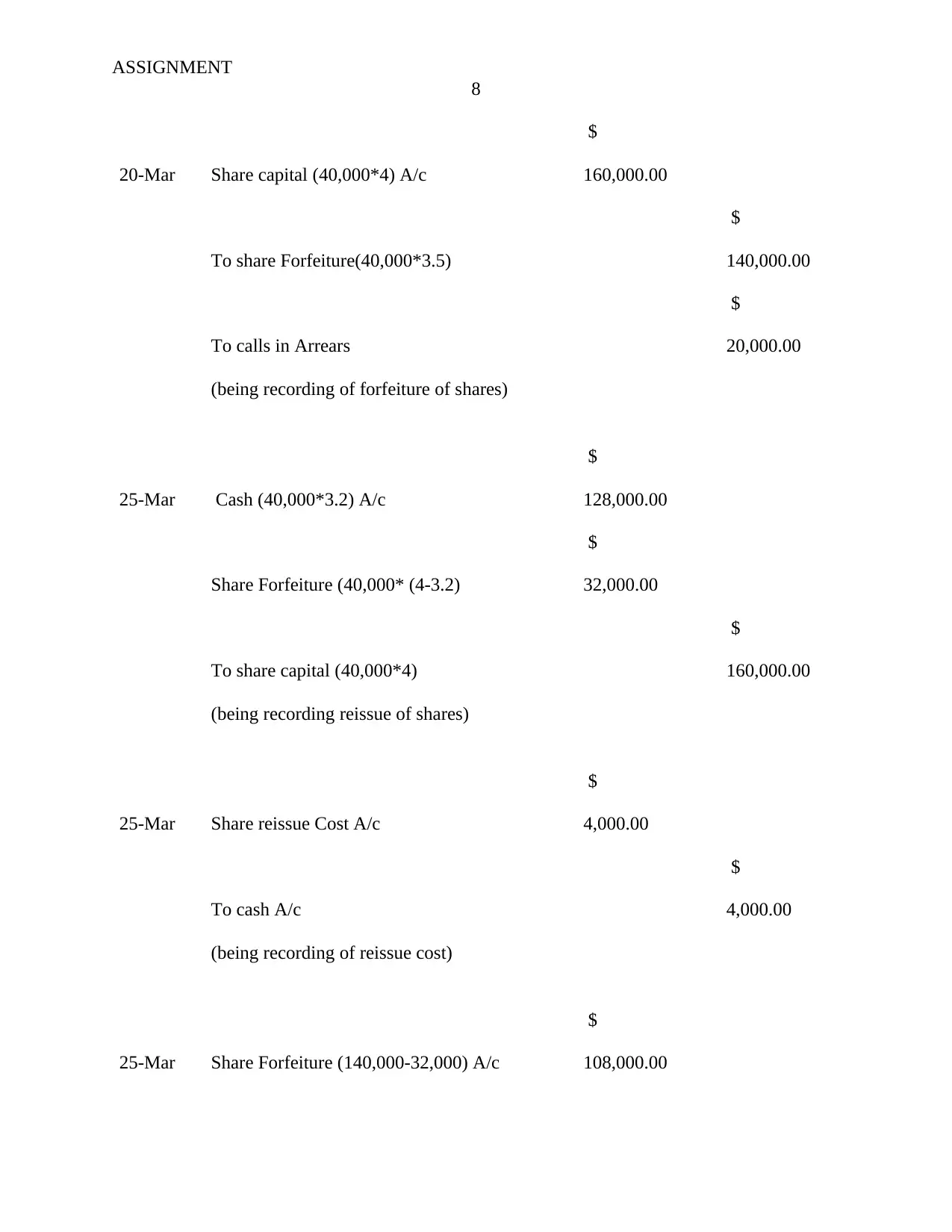
ASSIGNMENT
8
20-Mar Share capital (40,000*4) A/c
$
160,000.00
To share Forfeiture(40,000*3.5)
$
140,000.00
To calls in Arrears
$
20,000.00
(being recording of forfeiture of shares)
25-Mar Cash (40,000*3.2) A/c
$
128,000.00
Share Forfeiture (40,000* (4-3.2)
$
32,000.00
To share capital (40,000*4)
$
160,000.00
(being recording reissue of shares)
25-Mar Share reissue Cost A/c
$
4,000.00
To cash A/c
$
4,000.00
(being recording of reissue cost)
25-Mar Share Forfeiture (140,000-32,000) A/c
$
108,000.00
8
20-Mar Share capital (40,000*4) A/c
$
160,000.00
To share Forfeiture(40,000*3.5)
$
140,000.00
To calls in Arrears
$
20,000.00
(being recording of forfeiture of shares)
25-Mar Cash (40,000*3.2) A/c
$
128,000.00
Share Forfeiture (40,000* (4-3.2)
$
32,000.00
To share capital (40,000*4)
$
160,000.00
(being recording reissue of shares)
25-Mar Share reissue Cost A/c
$
4,000.00
To cash A/c
$
4,000.00
(being recording of reissue cost)
25-Mar Share Forfeiture (140,000-32,000) A/c
$
108,000.00
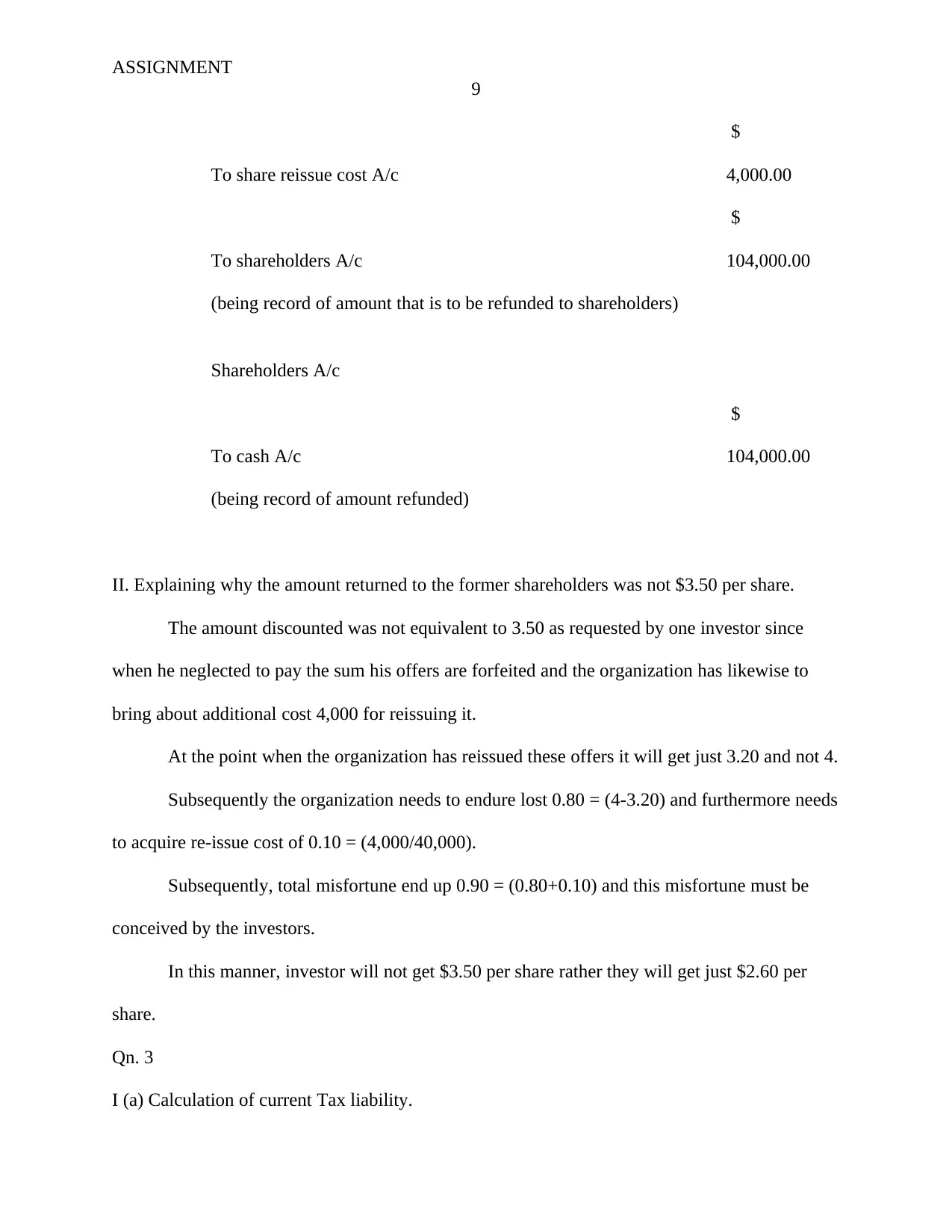
ASSIGNMENT
9
To share reissue cost A/c
$
4,000.00
To shareholders A/c
$
104,000.00
(being record of amount that is to be refunded to shareholders)
Shareholders A/c
To cash A/c
$
104,000.00
(being record of amount refunded)
II. Explaining why the amount returned to the former shareholders was not $3.50 per share.
The amount discounted was not equivalent to 3.50 as requested by one investor since
when he neglected to pay the sum his offers are forfeited and the organization has likewise to
bring about additional cost 4,000 for reissuing it.
At the point when the organization has reissued these offers it will get just 3.20 and not 4.
Subsequently the organization needs to endure lost 0.80 = (4-3.20) and furthermore needs
to acquire re-issue cost of 0.10 = (4,000/40,000).
Subsequently, total misfortune end up 0.90 = (0.80+0.10) and this misfortune must be
conceived by the investors.
In this manner, investor will not get $3.50 per share rather they will get just $2.60 per
share.
Qn. 3
I (a) Calculation of current Tax liability.
9
To share reissue cost A/c
$
4,000.00
To shareholders A/c
$
104,000.00
(being record of amount that is to be refunded to shareholders)
Shareholders A/c
To cash A/c
$
104,000.00
(being record of amount refunded)
II. Explaining why the amount returned to the former shareholders was not $3.50 per share.
The amount discounted was not equivalent to 3.50 as requested by one investor since
when he neglected to pay the sum his offers are forfeited and the organization has likewise to
bring about additional cost 4,000 for reissuing it.
At the point when the organization has reissued these offers it will get just 3.20 and not 4.
Subsequently the organization needs to endure lost 0.80 = (4-3.20) and furthermore needs
to acquire re-issue cost of 0.10 = (4,000/40,000).
Subsequently, total misfortune end up 0.90 = (0.80+0.10) and this misfortune must be
conceived by the investors.
In this manner, investor will not get $3.50 per share rather they will get just $2.60 per
share.
Qn. 3
I (a) Calculation of current Tax liability.
⊘ This is a preview!⊘
Do you want full access?
Subscribe today to unlock all pages.

Trusted by 1+ million students worldwide
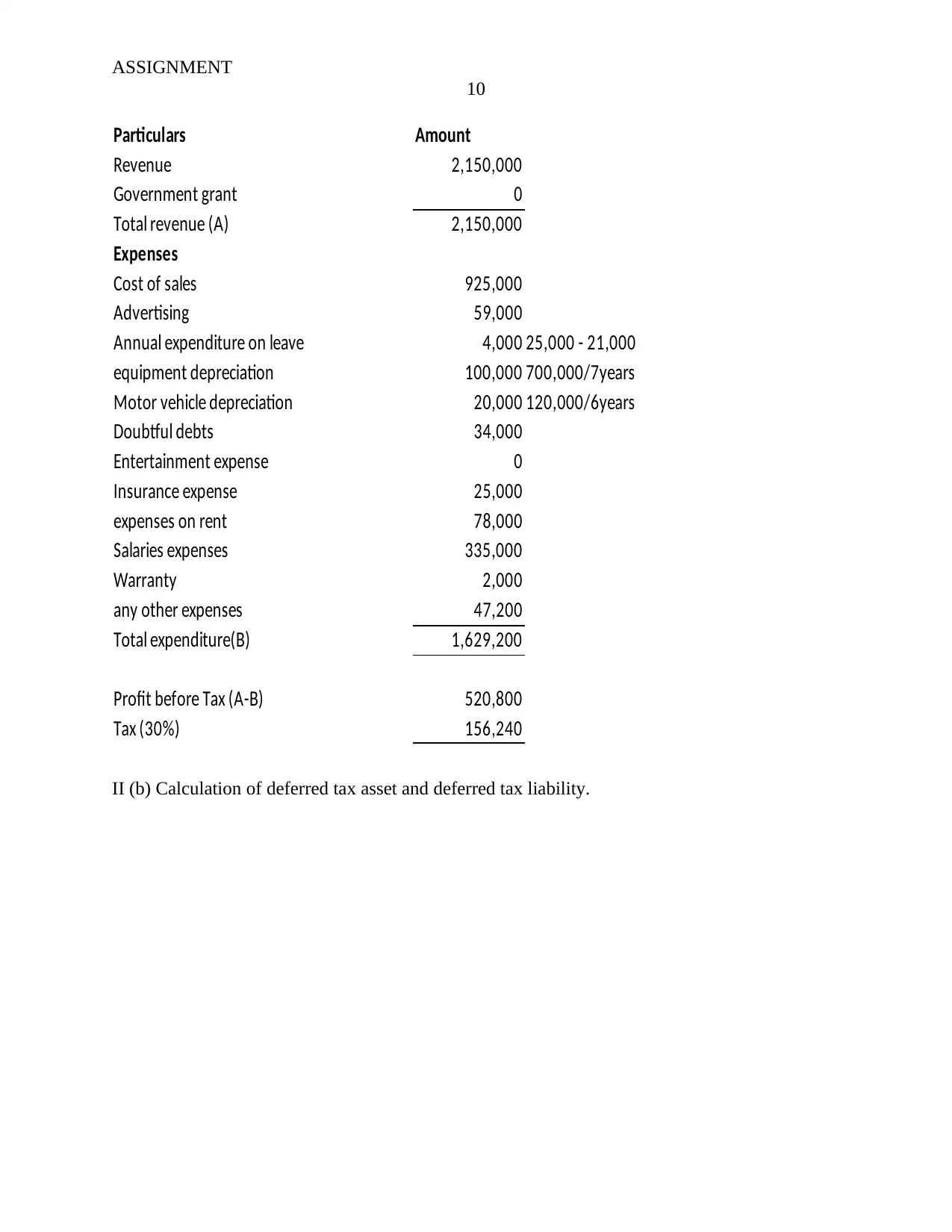
ASSIGNMENT
10
Particulars Amount
Revenue 2,150,000
Government grant 0
Total revenue (A) 2,150,000
Expenses
Cost of sales 925,000
Advertising 59,000
Annual expenditure on leave 4,000 25,000 - 21,000
equipment depreciation 100,000 700,000/7years
Motor vehicle depreciation 20,000 120,000/6years
Doubtful debts 34,000
Entertainment expense 0
Insurance expense 25,000
expenses on rent 78,000
Salaries expenses 335,000
Warranty 2,000
any other expenses 47,200
Total expenditure(B) 1,629,200
Profit before Tax (A-B) 520,800
Tax (30%) 156,240
II (b) Calculation of deferred tax asset and deferred tax liability.
10
Particulars Amount
Revenue 2,150,000
Government grant 0
Total revenue (A) 2,150,000
Expenses
Cost of sales 925,000
Advertising 59,000
Annual expenditure on leave 4,000 25,000 - 21,000
equipment depreciation 100,000 700,000/7years
Motor vehicle depreciation 20,000 120,000/6years
Doubtful debts 34,000
Entertainment expense 0
Insurance expense 25,000
expenses on rent 78,000
Salaries expenses 335,000
Warranty 2,000
any other expenses 47,200
Total expenditure(B) 1,629,200
Profit before Tax (A-B) 520,800
Tax (30%) 156,240
II (b) Calculation of deferred tax asset and deferred tax liability.
Paraphrase This Document
Need a fresh take? Get an instant paraphrase of this document with our AI Paraphraser
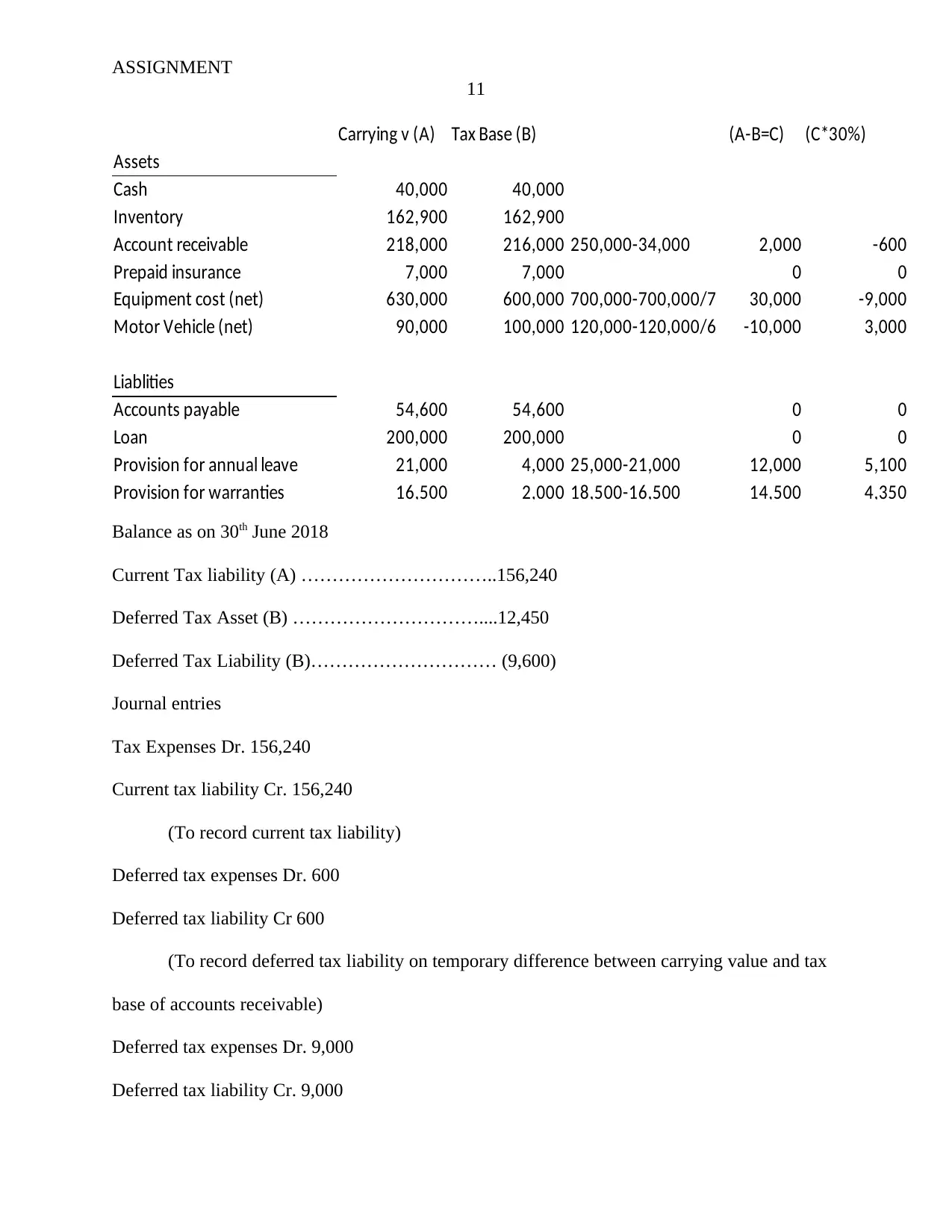
ASSIGNMENT
11
Carrying v (A) Tax Base (B) (A-B=C) (C*30%)
Assets
Cash 40,000 40,000
Inventory 162,900 162,900
Account receivable 218,000 216,000 250,000-34,000 2,000 -600
Prepaid insurance 7,000 7,000 0 0
Equipment cost (net) 630,000 600,000 700,000-700,000/7 30,000 -9,000
Motor Vehicle (net) 90,000 100,000 120,000-120,000/6 -10,000 3,000
Liablities
Accounts payable 54,600 54,600 0 0
Loan 200,000 200,000 0 0
Provision for annual leave 21,000 4,000 25,000-21,000 12,000 5,100
Provision for warranties 16,500 2,000 18,500-16,500 14,500 4,350
Balance as on 30th June 2018
Current Tax liability (A) …………………………..156,240
Deferred Tax Asset (B) …………………………....12,450
Deferred Tax Liability (B)………………………… (9,600)
Journal entries
Tax Expenses Dr. 156,240
Current tax liability Cr. 156,240
(To record current tax liability)
Deferred tax expenses Dr. 600
Deferred tax liability Cr 600
(To record deferred tax liability on temporary difference between carrying value and tax
base of accounts receivable)
Deferred tax expenses Dr. 9,000
Deferred tax liability Cr. 9,000
11
Carrying v (A) Tax Base (B) (A-B=C) (C*30%)
Assets
Cash 40,000 40,000
Inventory 162,900 162,900
Account receivable 218,000 216,000 250,000-34,000 2,000 -600
Prepaid insurance 7,000 7,000 0 0
Equipment cost (net) 630,000 600,000 700,000-700,000/7 30,000 -9,000
Motor Vehicle (net) 90,000 100,000 120,000-120,000/6 -10,000 3,000
Liablities
Accounts payable 54,600 54,600 0 0
Loan 200,000 200,000 0 0
Provision for annual leave 21,000 4,000 25,000-21,000 12,000 5,100
Provision for warranties 16,500 2,000 18,500-16,500 14,500 4,350
Balance as on 30th June 2018
Current Tax liability (A) …………………………..156,240
Deferred Tax Asset (B) …………………………....12,450
Deferred Tax Liability (B)………………………… (9,600)
Journal entries
Tax Expenses Dr. 156,240
Current tax liability Cr. 156,240
(To record current tax liability)
Deferred tax expenses Dr. 600
Deferred tax liability Cr 600
(To record deferred tax liability on temporary difference between carrying value and tax
base of accounts receivable)
Deferred tax expenses Dr. 9,000
Deferred tax liability Cr. 9,000
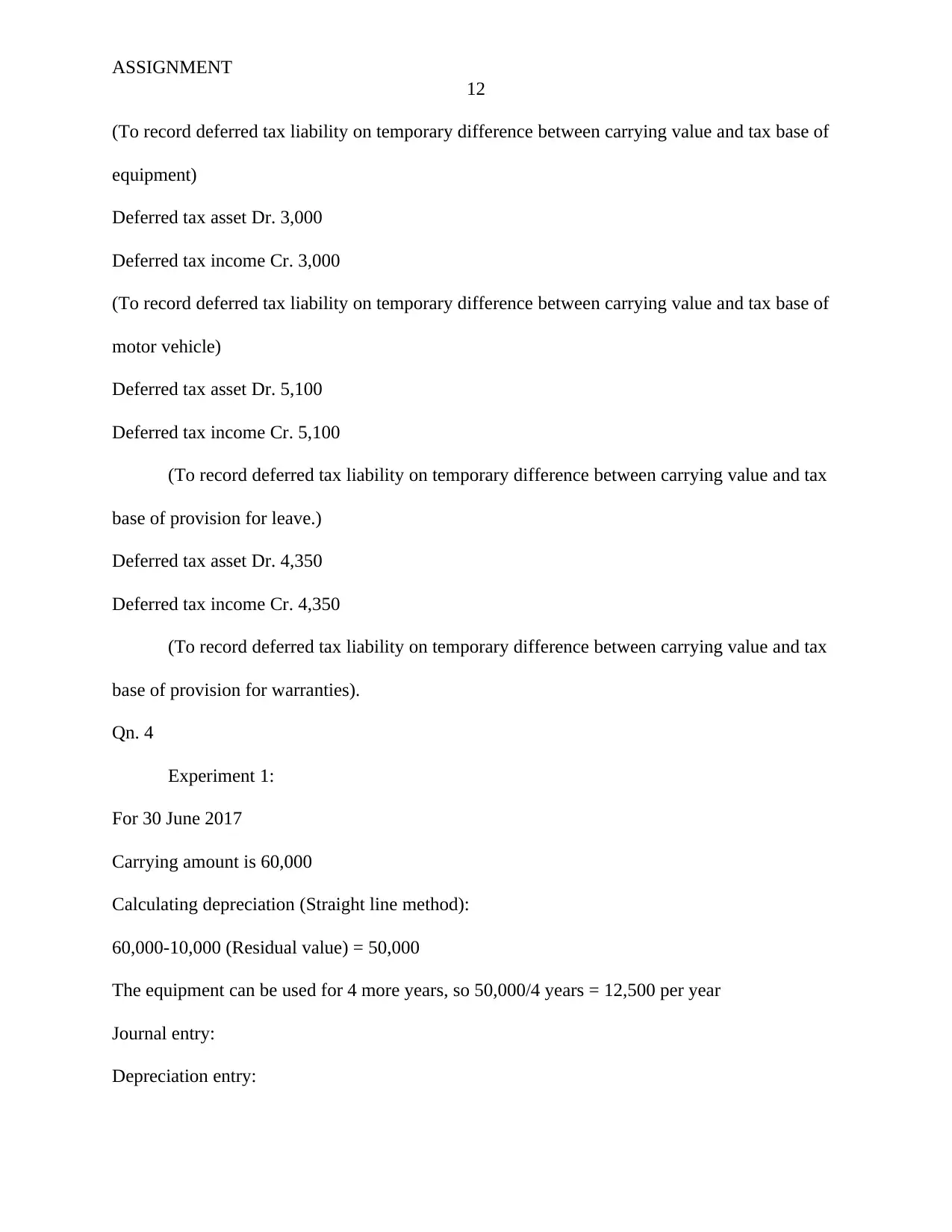
ASSIGNMENT
12
(To record deferred tax liability on temporary difference between carrying value and tax base of
equipment)
Deferred tax asset Dr. 3,000
Deferred tax income Cr. 3,000
(To record deferred tax liability on temporary difference between carrying value and tax base of
motor vehicle)
Deferred tax asset Dr. 5,100
Deferred tax income Cr. 5,100
(To record deferred tax liability on temporary difference between carrying value and tax
base of provision for leave.)
Deferred tax asset Dr. 4,350
Deferred tax income Cr. 4,350
(To record deferred tax liability on temporary difference between carrying value and tax
base of provision for warranties).
Qn. 4
Experiment 1:
For 30 June 2017
Carrying amount is 60,000
Calculating depreciation (Straight line method):
60,000-10,000 (Residual value) = 50,000
The equipment can be used for 4 more years, so 50,000/4 years = 12,500 per year
Journal entry:
Depreciation entry:
12
(To record deferred tax liability on temporary difference between carrying value and tax base of
equipment)
Deferred tax asset Dr. 3,000
Deferred tax income Cr. 3,000
(To record deferred tax liability on temporary difference between carrying value and tax base of
motor vehicle)
Deferred tax asset Dr. 5,100
Deferred tax income Cr. 5,100
(To record deferred tax liability on temporary difference between carrying value and tax
base of provision for leave.)
Deferred tax asset Dr. 4,350
Deferred tax income Cr. 4,350
(To record deferred tax liability on temporary difference between carrying value and tax
base of provision for warranties).
Qn. 4
Experiment 1:
For 30 June 2017
Carrying amount is 60,000
Calculating depreciation (Straight line method):
60,000-10,000 (Residual value) = 50,000
The equipment can be used for 4 more years, so 50,000/4 years = 12,500 per year
Journal entry:
Depreciation entry:
⊘ This is a preview!⊘
Do you want full access?
Subscribe today to unlock all pages.

Trusted by 1+ million students worldwide
1 out of 17
Related Documents
Your All-in-One AI-Powered Toolkit for Academic Success.
+13062052269
info@desklib.com
Available 24*7 on WhatsApp / Email
![[object Object]](/_next/static/media/star-bottom.7253800d.svg)
Unlock your academic potential
Copyright © 2020–2025 A2Z Services. All Rights Reserved. Developed and managed by ZUCOL.





